This type of sleep surface combines a conforming foam core with an additional layer of cushioning sewn to the top. The foam core offers support and pressure relief by distributing weight, while the upper layer provides a soft, padded feel. As an example, consider a standard innerspring mattress enhanced with both a conforming foam layer and a sewn-on, plush upper section.
The design presents a balance between support and comfort, addressing diverse sleep preferences. The conforming foam component adapts to the body’s contours, potentially alleviating pressure points. Historically, added cushioning was achieved solely through thicker innerspring mattresses. The introduction of foam technology and the integration of a dedicated, sewn-on upper section represent a significant advancement in sleep surface engineering, offering enhanced comfort and targeted support.
Subsequent sections will delve into the specific materials utilized in construction, explore the comparative advantages and disadvantages relative to other mattress types, and examine factors to consider when selecting a suitable product.
Selection Considerations for Enhanced Sleep Surfaces
The following guidelines provide insights into the selection process, emphasizing key attributes and considerations for optimal purchase decisions.
Tip 1: Assess Firmness Preference: Evaluate individual firmness requirements. Softer surfaces offer increased initial cushioning, while firmer options provide enhanced support for heavier individuals or those with specific spinal alignment needs. Sample mattresses in-store, or consider trial periods when purchasing online.
Tip 2: Consider Sleeping Position: Sleeping posture significantly influences mattress suitability. Side sleepers benefit from increased cushioning to alleviate pressure on hips and shoulders. Back sleepers generally require a firmer surface to maintain spinal alignment. Stomach sleepers typically need the firmest support to prevent excessive sinking.
Tip 3: Evaluate Foam Density: The density of the foam component impacts durability and longevity. Higher-density foams are generally more resistant to compression and provide extended performance. Lower-density foams may offer a more affordable initial price point but are prone to quicker degradation.
Tip 4: Review Materials and Construction: Examine the specific materials employed in the upper section and the core. Natural fibers, such as cotton or wool, offer enhanced breathability and moisture-wicking properties. The method of attachment and the quality of stitching contribute to overall durability.
Tip 5: Inspect Edge Support: Adequate edge support prevents sagging along the perimeter, maximizing the usable sleep surface. Reinforced edges are particularly beneficial for couples or individuals who tend to sleep near the edge of the bed.
Tip 6: Understand Warranty and Trial Period: Carefully review the manufacturer’s warranty coverage, including the terms and conditions. A generous trial period allows for adequate assessment of comfort and support over an extended period.
Adhering to these selection considerations can facilitate the acquisition of a sleep surface that effectively addresses individual needs, promoting optimal rest and recovery.
The subsequent section will provide a comparative analysis of alternative mattress technologies.
1. Pressure Relief
Pressure relief is a primary function of a sleep surface, crucial for minimizing discomfort and promoting restorative sleep. In the context of a pillow top memory foam mattress, this characteristic is achieved through a combination of conforming foam and the cushioning provided by the upper layer, aiming to distribute weight evenly and reduce concentrated pressure on specific body parts.
- Conforming Foam Composition and Pressure Redistribution
The conforming foam component, typically memory foam, possesses viscoelastic properties that allow it to mold to the contours of the body. This molding action distributes weight across a larger surface area, reducing pressure points that can lead to pain and discomfort, particularly in areas such as the hips, shoulders, and spine. For instance, when a side sleeper lies on a mattress, the conforming foam cushions and supports the protruding hip, preventing localized pressure buildup that could disrupt sleep.
- Pillow Top Layer and Enhanced Cushioning
The upper layer enhances pressure relief by providing an initial layer of plush cushioning. This layer acts as a buffer between the body and the firmer support core, immediately reducing pressure upon contact. Consider a mattress with a thin upper section compared to one with a thicker, more substantial cushioning layer. The latter would likely offer superior initial pressure reduction, especially for lighter individuals.
- Density and Firmness Considerations for Pressure Point Mitigation
The density and firmness of the foam layers influence pressure relief effectiveness. Lower-density foams may compress excessively, negating the intended cushioning effect. Conversely, excessively firm foams may not conform adequately, resulting in inadequate pressure distribution. The optimal combination strikes a balance between support and conformance, effectively mitigating pressure points while maintaining spinal alignment.
- Impact on Circulation and Sleep Quality
Effective pressure relief can improve circulation by reducing compression on blood vessels. Restricted blood flow can contribute to discomfort and restlessness during sleep. A mattress that effectively minimizes pressure points can, therefore, promote more restful and uninterrupted sleep, leading to improved overall sleep quality and daytime function. This is especially beneficial for individuals with conditions such as arthritis or fibromyalgia, where pressure sensitivity is heightened.
In conclusion, the pressure-relieving qualities of a pillow top memory foam mattress are a result of the synergistic effect of the conforming foam base and the added cushioning of the upper section. These features work in concert to distribute weight, minimize concentrated pressure, and promote improved circulation and sleep quality. The effectiveness of pressure relief is dependent on factors such as foam density, firmness, and the quality of materials used in construction.
2. Motion Isolation
Motion isolation is a critical attribute of sleep surfaces, particularly relevant for individuals sharing a bed. Its efficacy in minimizing the transmission of movement is significantly influenced by the construction and materials used in a pillow top memory foam mattress.
- Viscoelastic Properties of Memory Foam
Memory foam, a primary component of many such mat
tresses, possesses viscoelastic properties that enable it to absorb and dampen movement at the point of impact. Unlike traditional innerspring mattresses, which can transfer motion across the entire surface, memory foam compresses locally, minimizing disturbance to other areas of the bed. For instance, when one partner shifts position during the night, the other partner experiences reduced motion transfer compared to a traditional spring mattress. - Pillow Top Layer and Motion Absorption
The pillow top layer, typically composed of fibers or foam, contributes to motion isolation by providing an additional layer of cushioning. This layer absorbs initial impact, further reducing the propagation of movement across the mattress surface. A thicker, denser upper section generally exhibits greater motion-absorbing capabilities.
- Density and Thickness of Foam Layers
The density and thickness of the foam layers within the mattress directly affect motion isolation performance. Higher-density foams tend to absorb more energy and dampen vibrations more effectively. A thicker foam layer provides a greater barrier to motion transfer compared to a thinner layer, regardless of foam type.
- Support Core and Motion Dampening
While the upper layers primarily address initial motion absorption, the support core plays a role in dampening residual movement. A high-density foam core or a system of individually pocketed coils can minimize the spread of motion generated by the upper layers. Conversely, a less robust support core may allow more motion to propagate throughout the mattress.
The motion isolation capabilities of a pillow top memory foam mattress are a composite effect of the viscoelasticity of the memory foam, the cushioning provided by the upper section, and the density and construction of both the foam layers and the support core. Mattresses with superior motion isolation are particularly beneficial for couples, individuals sensitive to movement, or those who experience restless sleep patterns in their partners.
3. Temperature Regulation
Temperature regulation within a sleep surface is a crucial factor influencing sleep quality. In the context of a pillow top memory foam mattress, the materials and construction methods employed significantly impact its capacity to dissipate heat and maintain a comfortable sleep environment.
- Memory Foam Density and Heat Retention
Traditional memory foam, known for its pressure-relieving qualities, often exhibits a tendency to retain heat due to its dense, closed-cell structure. This characteristic can lead to elevated sleep surface temperatures, potentially causing discomfort and disrupting sleep patterns. The degree of heat retention is directly proportional to the density of the foam; higher-density foams typically exhibit greater heat retention. As an example, a high-density memory foam mattress might feel warm during the night, whereas a lower-density option may remain cooler.
- Pillow Top Materials and Breathability
The materials used in the pillow top layer can either mitigate or exacerbate the heat retention properties of the underlying memory foam. Natural fibers, such as cotton or wool, possess inherent breathability and moisture-wicking properties, promoting airflow and facilitating heat dissipation. Synthetic materials, conversely, may restrict airflow and contribute to increased heat buildup. A pillow top constructed with breathable cotton, for instance, would likely result in a cooler sleep surface compared to one made with polyester.
- Open-Cell Memory Foam Technology
To address the heat retention issue, manufacturers have developed open-cell memory foam. This technology incorporates structural modifications to the foam, creating interconnected air passages that enhance ventilation. Open-cell foam allows heat to dissipate more effectively, reducing the likelihood of overheating. A mattress using open-cell foam, coupled with a breathable pillow top, aims to provide a cooler sleep experience.
- Cooling Gel Infusions
Another strategy employed to improve temperature regulation is the infusion of cooling gels or phase-change materials into the memory foam. These materials absorb and dissipate heat, helping to maintain a more consistent temperature. The effectiveness of cooling gel infusions depends on the concentration and distribution of the material within the foam. Mattresses with a higher concentration of cooling gel generally provide enhanced cooling performance.
The temperature regulation performance of a pillow top memory foam mattress is a complex interaction between the inherent properties of memory foam and the materials and technologies used to enhance breathability and heat dissipation. Understanding these factors is essential for selecting a mattress that provides a comfortable and temperature-neutral sleep environment.
4. Support Core Durability
The longevity and performance of a pillow top memory foam mattress are intrinsically linked to the durability of its support core. The support core, typically composed of high-density foam or an innerspring system, provides the foundational support and structural integrity necessary to maintain the mattress’s shape and prevent sagging over time. The durability of this component directly impacts the overall lifespan and comfort level of the mattress. For example, a support core made of low-density foam may degrade rapidly under consistent pressure, leading to premature sagging and a loss of support, effectively compromising the benefits of the memory foam and pillow top layers. Conversely, a robust support core, constructed of high-density materials, will resist compression and maintain its shape for a longer period, preserving the mattress’s intended comfort and support characteristics. Selecting a pillow top memory foam mattress with a durable support core is therefore crucial for long-term satisfaction and value.
Consider the practical implications of support core degradation. As the support core weakens, the memory foam and pillow top layers become less effective at distributing weight and relieving pressure. This can lead to the development of pressure points, increased discomfort, and potentially, disrupted sleep. In the case of an innerspring core, coil fatigue or breakage can create unevenness and instability across the mattress surface, further compromising its functionality. Moreover, the degradation of the support core can accelerate the wear and tear on the upper layers, shortening the overall lifespan of the mattress. Routine rotation of the mattress may help distribute wear more evenly but cannot fully compensate for inherent deficiencies in support core durability.
In summary, the durability of the support core is a critical determinant of the long-term performance and value of a pillow top memory foam mattress. A robust support core provides the necessary foundation for maintaining the mattress’s shape, preventing sagging, and preserving its intended comfort and support characteristics. Consumers should carefully consider the materials and construction of the support core when selecting a mattress, prioritizing high-density foams or well-engineered innerspring systems to ensure long-term durability and satisfaction.
5. Edge Support Integrity
Edge support integrity is a critical, though often overlooked, factor in the overall performance and longevity of a pillow top memory foam mattress. This refers to the structural reinforcement along the perimeter of the mattress, designed to prevent sagging and maintain a consistent level of support across the entire surface.
- Reinforced Perimeter Construction and Stability
Reinforced perimeter construction typically involves the use of high-density foam rails or strategically placed innerspring coils along the edges of the mattress. These elements provide additional support, preventing the edges from collapsing under pressure. Without this reinforcement, the edges are prone to sagging, particularly under sustained use, reducing the usable sleep surface and making it difficult to sit comfortably on the edge of the bed. For instance, a mattress with a robust foam encasement around its perimeter will offer greater stability and resist sagging compared to one without such reinforcement.
- Foam Density and Edge Resilience
The density of the foam used in the edge support system directly correlates with its ability to resist compression and maintain its shape over time. Higher-density foams exhibit greater resilience and are less prone to deformation, providing consistent support along the edges of the mattress. Low-density foams, on the other hand, may compress and degrade rapidly, leading to premature sagging and a reduction in usable sleep space. A mattress with high-density foam rails will maintain its edge support for a longer period compared to one with lower-density foam.
- Impact on Usable Sleep Surface and Comfort
Effective edge support maximizes the usable sleep surface of the mattress, allowing individuals to sleep closer to the edge without feeling like they are going to roll off. This is particularly important for couples or individuals who share a smaller bed. Furthermore, strong edge support provides a stable surface for sitting on the edge of the bed, facilitating activities such as dressing or reading. A mattress with inadequate edge support can feel unstable and uncomfortable, particularly when sitting near the edge.
- Longevity and Overall Mattress Performance
Consistent edge support contributes to the overall longevity and performance of the mattress. By preventing sagging and maintaining a level sleeping surface, strong edge support helps to distribute weight evenly across the mattress, reducing stress on the core support system and extending the life of the mattress. Mattresses with inadequate edge support are more prone to uneven wear and tear, leading to premature degradation and a reduction in overall comfort and support.
The relationship between edge support integrity and the overall performance of a pillow top memory foam mattress is therefore significant. Adequate edge support not only maximizes the usable sleep surface and provides a stable seating area but also contributes to the long-term durability and comfort of the mattress, ensuring consistent support and minimizing sagging over time.
Frequently Asked Questions About Pillow Top Memory Foam Mattresses
The subsequent section addresses common inquiries pertaining to pillow top memory foam mattresses, providing detailed and informative responses.
Question 1: What is the typical lifespan of a pillow top memory foam mattress?
The average lifespan ranges from 7 to 10 years, contingent upon the quality of materials used, the density of the foam, and the frequency of use. Proper maintenance, including regular rotation, can extend the lifespan.
Question 2: Are pillow top memory foam mattresses suitable for individuals with back pain?
The suitability depends on the firmness and support characteristics of the specific mattress. The conforming foam can provide pressure relief, potentially alleviating discomfort. However, individuals with significant back pain should consult with a medical professional to determine the optimal mattress type.
Question 3: How does a pillow top memory foam mattress compare to a traditional innerspring mattress?
Pillow top memory foam mattresses generally offer superior pressure relief and motion isolation compared to traditional innerspring mattresses. Innerspring mattresses may provide greater bounce and airflow, but often lack the conforming support of memory foam.
Question 4: What is the ideal firmness level for a pillow top memory foam mattress?
The ideal firmness level is subjective and depends on individual preferences, sleeping position, and body weight. Side sleepers typically benefit from a medium-firm mattress, while back and stomach sleepers may prefer a firmer option.
Question 5: Are pillow top memory foam mattresses prone to overheating?
Traditional memory foam can retain heat. However, advancements in foam technology, such as open-cell construction and gel infusions, aim to mitigate heat retention and improve breathability. The materials used in the pillow top layer also influence temperature regulation.
Question 6: How should a pillow top memory foam mattress be cleaned and maintained?
Regular vacuuming helps remove dust and allergens. Spot cleaning with a mild detergent and water is recommended for stains. A mattress protector can prevent spills and extend the lifespan of the mattress. Rotation every 3-6 months promotes even wear.
The key takeaway is that the suitability and longevity of a pillow top memory foam mattress depend on individual needs and proper maintenance.
The subsequent section will explore user reviews and ratings.
Pillow Top Memory Foam Mattress
This examination has dissected the construction and attributes of the sleep surface, encompassing its design, materials, and performance characteristics. The discussion highlighted pressure relief, motion isolation, temperature regulation, support core durability, and edge support integrity as critical factors influencing overall suitability and longevity. The assessment of these facets provides a framework for informed decision-making.
Ultimately, the selection of such product necessitates a careful consideration of individual requirements and preferences. Prioritizing informed evaluation and objective assessment ensures that the investment aligns with intended purposes, promoting optimal sleep and long-term satisfaction. Further research and critical analysis of evolving technologies will likely shape future iterations of sleep surfaces, potentially addressing existing limitations and enhancing overall performance.


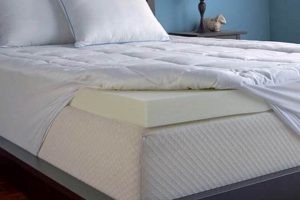
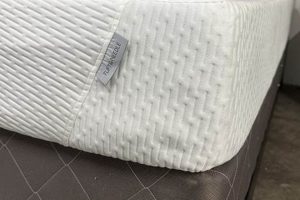
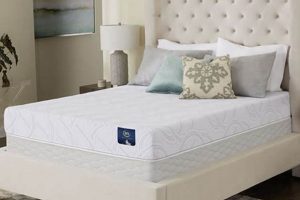
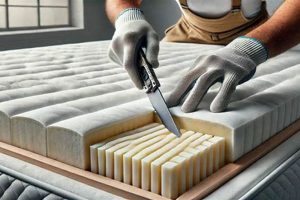
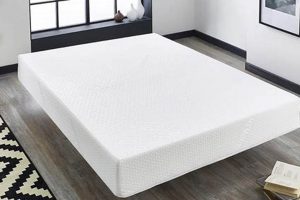
![Best Memory Foam Mattress Queen Walmart [Deals!] Organic & Natural Mattress Buyer’s Guide: Non-Toxic Sleep Solutions Best Memory Foam Mattress Queen Walmart [Deals!] | Organic & Natural Mattress Buyer’s Guide: Non-Toxic Sleep Solutions](https://mattressworldpa.com/wp-content/uploads/2025/07/th-3980-300x200.jpg)